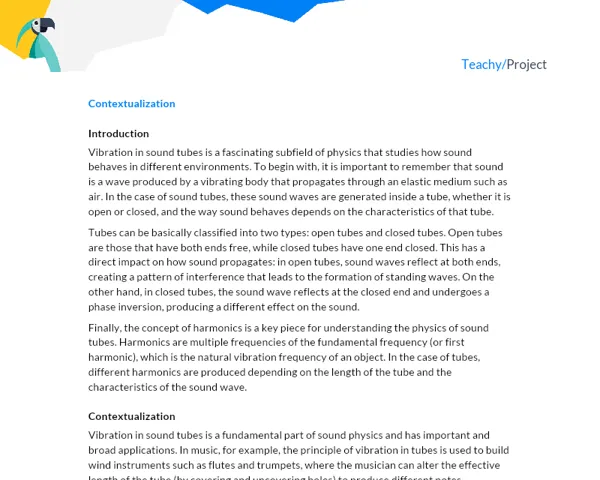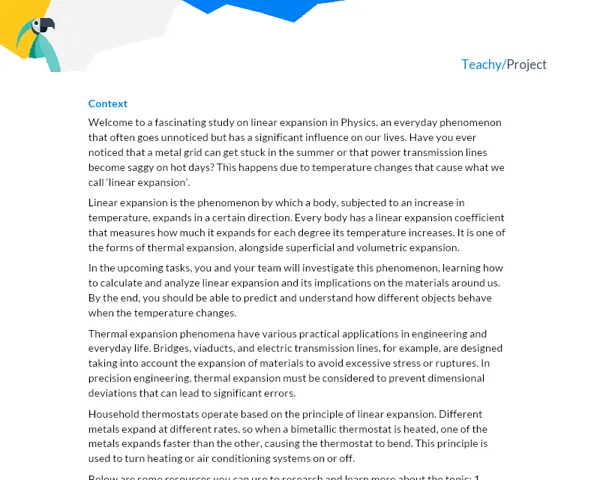Contextualization
Theoretical Introduction
Latent heat is a fundamental concept in physics, particularly in thermodynamics. Traditionally, latent heat is defined as the amount of heat required to change the physical state of a substance without changing its temperature. This heat is "latent," meaning hidden, because it does not result in a temperature change during the phase transition.
A common example is ice melting. If you place an ice cube at room temperature, it will change from a solid to a liquid at the same temperature - 0°C. The heat that caused this change is latent heat. This conception is very important to understand why some foods take longer to cook than others, even when they are at the same temperature.
The subject becomes more complex - and fascinating - when we consider the latent heat of vaporization. This is the heat that a substance needs to transition from a liquid to a gas state, again without a temperature change. However, the latent heat of vaporization is significantly higher than that of fusion, leading to various interesting real-world applications.
Contextualization
Latent heat has a huge impact on our daily world. It comes into play when cooking, when your body sweats to cool down, and is crucial for the efficiency of internal combustion engines. A deep understanding of latent heat can lead to technological advancements in areas such as air conditioning, energy production, food preservation, and much more.
Furthermore, latent heat is a key component in our climate system. The latent heat of water vaporization plays a fundamental role in transferring heat from the Earth's surface to the atmosphere, driving global and regional climate patterns. Therefore, understanding latent heat not only enhances our understanding of the physical world but can also help mitigate and adapt to climate change.
Activity
Activity Title: "Unveiling the Latent World: An Experimental Investigation on Latent Heat"
Project Objective
The objective of this project is to provide a practical and in-depth understanding of the concept of latent heat through practical experiments, data analysis, and integration with other disciplines such as mathematics and chemistry.
Students, divided into groups of 3 to 5, will be challenged to conduct experiments to measure the latent heat of fusion and vaporization of different substances, analyze the collected data, and finally apply these concepts in a real-world context.
Project Duration: estimated at 15 hours of work per student.
Detailed Project Description
In general terms, the project consists of the following steps:
- Theoretical study and experiment preparation
- Conducting experiments
- Analysis of the data obtained
- Integration of knowledge and application in a real-world context
- Writing an academic report
Required Materials
- Substances for testing (water, ethyl alcohol, and paraffin)
- Precision balance
- Stopwatch
- Thermometer
- Calorimeter
- Electric stove or heating plate
- Beaker cups
- Data analysis software (Excel, Google Sheets, etc.)
Detailed Step-by-Step for Activity Execution
-
Theoretical study and experiment preparation: Students must review the concepts of heat and latent heat, studying the suggested sources and others they consider relevant. In addition, they must formulate hypotheses about the possible results of the experiments.
-
Conducting experiments: Each group will conduct experiments to determine the latent heat of fusion and vaporization of each substance. To do this, they will measure the time required for the substance to change state and the amount of heat required for this, using the following relationship: Q = mL, where Q is the heat, m is the mass of the substance, and L is the latent heat.
-
Analysis of the data obtained: The groups will analyze the collected data, comparing the values of latent heat of fusion and vaporization of each substance.
-
Integration of knowledge and application in a real-world context: Each group must select a real-world application impacted by latent heat (such as climatology, renewable energy, refrigeration, etc.) and explain how understanding latent heat can contribute to improvements in that area.
-
Writing an academic report: Finally, as part of the project delivery, each group will write an academic report in the following format:
a. Introduction: Contextualization of the theme, explanation of the relevance of latent heat in the real world, project problem, and objectives.
b. Development: Detailed explanation of latent heat theory, description of the experiments (including methodology and results), and discussion of the data obtained.
c. Conclusion: Discussion of the significance of the results, the learnings obtained in the project, and additional conclusions.
d. Bibliography: References of all information sources used in the project.
This project goes beyond simple theoretical understanding. It encourages students to conduct experiments, interpret data, make connections with the real world, and effectively communicate their findings. Additionally, the final report allows students to enhance their writing skills and academic organization.



